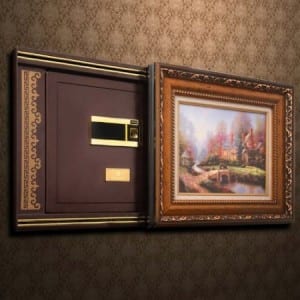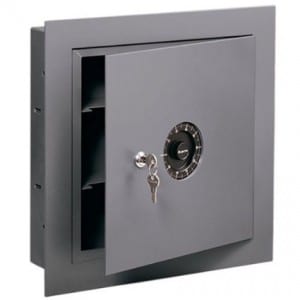Last Updated: by Jeffrey Huber

Table of contents
Gun safes can be purchased online or from gun shops all over, and they differ depending on prices, shapes, and dimensions. Every safe is not the same, so it's only common sense that you do your research first before investing in one.
An efficient, secure storage for your firearms will keep them away from children and criminal elements. Other than safeguarding your weapons, a safe also functions as a refuge for your valuables and important, fragile documents during natural disasters.
A gun safe is an investment that you can attach importance to for years, pretty much like the invaluable objects, it is sheltering. In this article, we are going to discuss the different kinds of gun safes available that you can decide on.
Different Types of Gun Safes
Biometric Lock
Also known in the storage business as a Fingerprint Safe, this safe can be opened up by means of unique fingerprints. It does not rely on keys nor combinations. Nobody but the user of the biometric lock storage can get access to its contents inside.
It is considered as the greatest in terms of personalized security. It trumps other methods when it comes to speed and can be accessed in just 1-2 seconds. It can also limit the number of persons who can get access to the items kept inside it.
This method is basically straightforward to use, and it does not entail memorizing combinations or checking your keys. In addition, it is also tamper-resistant thereby making this kinda strong candidate for your top pick.
One disadvantage of this device, though, is that it needs the power to function. It can rely on battery power or plugged into a wall socket to get AC power. Lastly, you will have to spend more to invest in this safe since it costs more than the others.
Many biometric lock gun safes have an override lock with a key hidden on the side of the gun safe or at the back of the safe. This is just in case the biometric reader doesn't work and you need access to your gun.
Electric Lock
Considered as handier than a conventional dial lock, this particular type is also easier to open. Electric locks often have safeguards built inside them so it will lock itself out after several faulty attempts.
It has a keypad which is utilized to input a numeric code and once these numbers were entered properly, the safe will finally unlock. It is powered by an in-house battery and is quite popular because of its aesthetics.
The backlit technology of this device makes unlocking safes in dimly-lit areas easier. Its ample font size is also an advantage to the visually-impaired.
However, it has its disadvantages too. Since the lock relies on battery power, it is susceptible to power outage. It is also subject to the dreaded automatic lock-outs.
Many electric lock gun safes have an override lock with a key hidden on the side of the gun safe or at the back of the safe. This is just in case the power to the electric lock doesn't work, and you need access to your gun.
Electromagnetic threats can also destroy the battery inside it and water-related natural disasters like floods and storms can quickly kill the functionality of this lock.
The Electronic-Mechanical lock merges the features and functions of an electronic lock (sizable fonts, backlit keypad, and battery) with the functions of a mechanical lock whenever power outages happen. It was proven to be advantageous during emergency situations and is natural disaster-proof too.
Dial Lock

This lock is also difficult to decode. Multiple dial locks can range from 000-999, and combinations can range by the thousands and with each attempt, the thief has to estimate the accurate sequence.
The dial lock is also long-standing since it does not need AC or battery power to function.
Unfortunately, it does not bode well when it comes to emergency situations. Emergencies require fast solutions, and you can only budge the dials of the lock as fast as it allows you.
This kind of lock also bears small, hard-to-read indentations signifying the numbers since its design requires placement of 100 indentations shaped into a circle. You might need a good pair of glasses to see those tiny indentations first if you are visually impaired, or a magnifying glass.
Hidden / In-Wall

Hidden or in-wall safes are installed right smack into the wall so it won't get taken away by robbers. They have electronic or fingerprint locks and range from small and large sizes to take in a variety of firearms. However, they are still considered more sizable than your standard safe.
They are also designed to be indistinguishable, so this kind offers plenty of security for gun owners. Superior-quality in-wall storage is designed to be waterproof.
Car Gun Safe
If you only own one handgun or pistol and you need to travel in your car, a car gun safe to store your firearm in is greatly recommended. They are handy, so you can mount it in your car or take it out of your car to your hotel room, and it also comes with various types of locks.
Mechanical Lock
One of the oldest kinds of safe gun locks, mechanical locks include a dial which rotates clockwise, then counter-clockwise, and once a 3-digit sequence has been inputted, it will finally unlock. Often dependable, this kind of lock has been chosen by many because of its functionality.
It is hard-wearing because of its mechanical components. You can get access anytime you need with the correct combination, and you don't have to deal with batteries either. Because it is mechanical, you don't have to worry about electromagnetic risks.
The lock, however, is not perfect for emergencies. It is slower to unlock, and it requires to be opened manually following each use.
Firearms require primary responsibility, which means you have to keep those devices stored away whenever it's not in use. Do take into account the list of the different types of gun safes mentioned in this article and decide on the safe that will suit your need and your location.